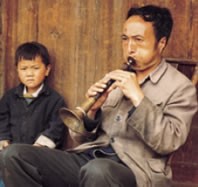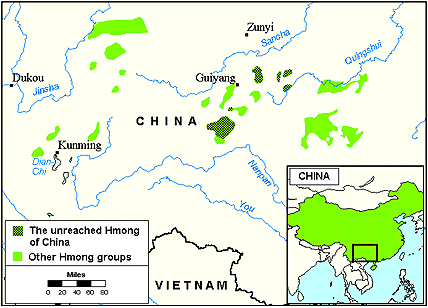The minority peoples of southern Guizhou are among the poorest in Asia and face mounting health risks. According to United Nation's figures for the late 1980s, only 22% of Guizhou's rural villages had access to an improved water source (running water, pump, or well). "The main source is usually a river or pond which is affected by droughts and almost always polluted from factory waste, seepage of agricultural chemicals, and human and animal waste."
The Western Mashan Miao language - which has 13 recognizable tones - does not have a written script.
A festival on the eighth day of the fourth lunar month commemorates the death of Ya Nu, who was killed in action as he led the Miao into battle against the Chinese 1,700 years ago.
The majority of Western Mashan Miao are hardworking peasants. They are also talented musicians, composing songs for festivals and creating energetic and demonstrative dances. Because of the region's mountainous terrain, it often takes several hours to walk down into the valley and up again to reach a village on a nearby hill. Without the use of telephones, the Miao have learned to project their voices across the valleys and trees to reach a neighboring village.
The Western Mashan Miao put their trust in the spirit world. If a crop fails or a woman cannot produce children to help with work in the fields, the village could face starvation. As a result, an intricate system of spirit appeasement gradually developed. The Miao believe that if they make peace with the spirits, the survival and prosperity of their communities will be ensured.
The Western Mashan Miao have no knowledge of the gospel.
Without the guidance of Christ, these people are like sheep without a shepherd. They need the good shepherd in their families and communities.
Pray for the spiritual blindness and bondage to the evil one to be removed so they can understand and respond to Christ.
Pray for the Lord to provide for their physical and spiritual needs as a testimony of his power and love.
Pray that the Western Mashan Miao people will have a spiritual hunger that will open their hearts to the King of kings.
Pray for an unstoppable movement to Christ among them.
Scripture Prayers for the Miao, Mashan Western in China.
Operation China, Asia Harvest, Copyrighted © Used with permission
| Profile Source: Joshua Project |











